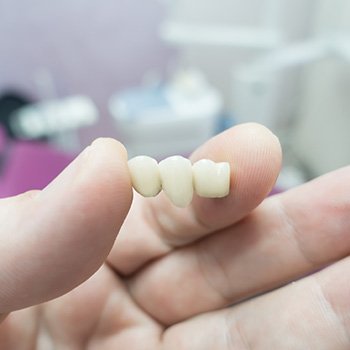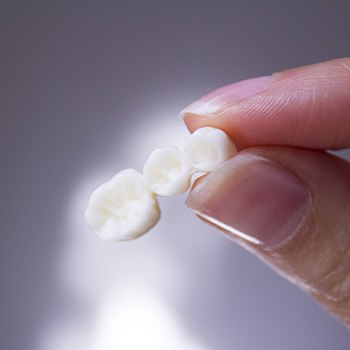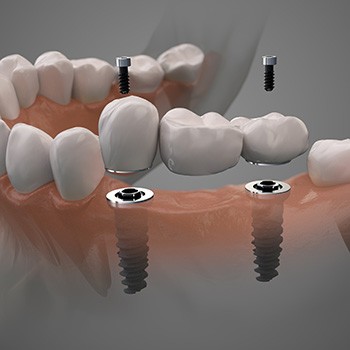Dental Bridges – Wylie, TX
Making Your “Smile Gaps” Disappear

It’s pretty clear that any kind of tooth loss isn’t good for your grin. Whether you lose one or many, you’ll get smile gaps that harm your looks, oral health, and more. Still, losing several adjacent teeth is especially bad; this issue can quickly draw unwanted attention. The good news is that our practice can handle it with its dental bridges in Wylie! To learn about them and how they work, simply keep reading or visit our office soon.
What is a Dental Bridge?

Like a denture or dental implant, a dental bridge is an oral prosthetic. It’s often made of special materials fused to either side of an artificial tooth or “pontic.” That design lets it replace one to four missing adjacent teeth, “bridging” the gap in your smile.
As expected, the best dental bridge candidates have missing adjacent teeth. These patients are the ones who benefit the most from care; they can have their smiles restored in one treatment. That said, almost any healthy adult can qualify for dental bridges – the devices have few requirements.
The Types of Dental Bridges

During your consultation, Dr. Morton will check your smile to see if dental bridges would help. He’ll then use the feedback from his exam to tailor your treatment plan. As part of that process, he’ll likely suggest you get one of the following dental bridges:
Traditional Dental Bridge

A traditional dental bridge is the kind dentists have used most over the years. In terms of design, it consists of dental crowns fused to either side of an artificial tooth (i.e., a “pontic”). That means the traditional bridge fastens to your nearby natural teeth to stay secure.
The biggest upside to the traditional bridge is that it costs (relatively) less. The materials it uses aren’t rare, so the device isn’t very expensive. That said, a dentist must alter some of your teeth to place it.
Implant Bridge

Per its name, an implant bridge uses dental implants – metal posts placed in your jaw. When these smaller restorations fuse with your jaw, they keep the larger device stable and steady. The result is that an implant bridge should never fall or come loose.
Many patients like that implant bridges don’t alter existing teeth. Thanks to their dental implants, a dentist doesn’t have to “prep” nearby teeth to place them. The downside is that implant bridges can be a tad costly.
The Benefits of Getting a Dental Bridge

Our office’s dental bridges provide perks like:
- Better Oral Health – A placed dental bridge stops harmful bacteria from spreading in your mouth. In doing so, it reduces your risk of gum disease and other oral issues.
- A Beautiful Smile – Dental bridges blend with your smile due to their quality materials. In fact, they often look so lifelike that others may not know you have one.
- Easy Eating – Thanks to the teeth it provides, a dental bridge can help you chew foods more easily.
- Lasting Effects – While an average dental implant lasts 5-15 years, a well-maintained one can work for 20 years or more.
Clearly, you don’t need to live with the gaps in your grin. Just see us for dental bridges – they’ll make your smile whole again!
